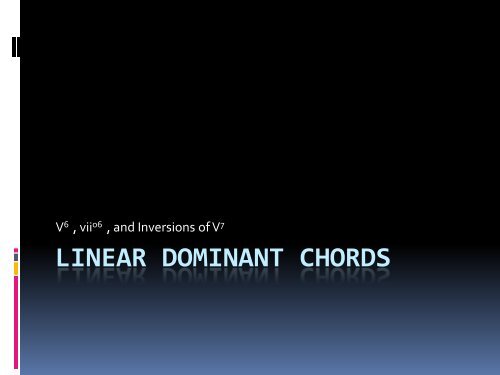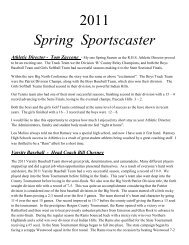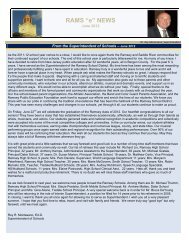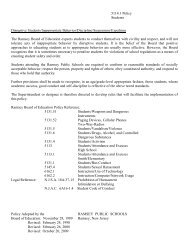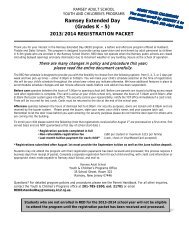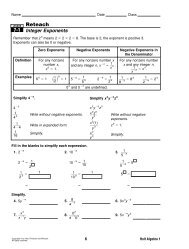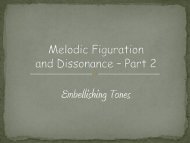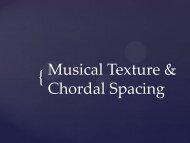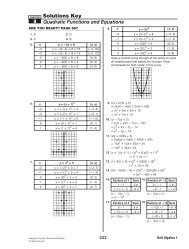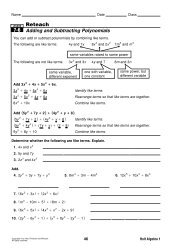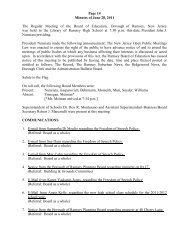Linear Dominant Chords
Linear Dominant Chords
Linear Dominant Chords
You also want an ePaper? Increase the reach of your titles
YUMPU automatically turns print PDFs into web optimized ePapers that Google loves.
V 6 , vii o6 , and Inversions of V 7<br />
LINEAR DOMINANT CHORDS
Introduction<br />
• Expanded bass line options (chords built on<br />
^7, ^2, & ^4<br />
First inversion dominant - V 6<br />
First inversion leading-tone triad – vii 06<br />
Inversions of the dominant seventh<br />
• V 6/5 ,V 4/3 , and V 4/2 in both major and minor
The V 6 , vii o6 & inversions of V 7<br />
• V chords retain chord quality in both major<br />
and minor modes<br />
• <strong>Chords</strong> built on the leading-tone (vii) are<br />
usually found in first inversion; root position<br />
and second inversion contain a tritone in the<br />
outer voices<br />
• Mm7 harmonies: V 6/5 ,V 4/3 , and V 4/2
V chord varieties<br />
In bass: ^5 ^7 ^2 ^4<br />
• New chords contain active scale degrees in the bass that<br />
want to move to more stable scale degrees in the tonic<br />
• These chords occur most often in the phrase and<br />
function as linear or embellishing dominant harmonies;<br />
embellish the tonic by passing, neighboring, or<br />
incomplete neighboring motion in the bass<br />
• Appear only rarely as part of a cadence formula
Uses of the V 6<br />
• No specific part-writing guidelines; double<br />
the soprano – never the bass (its the LT)<br />
• Bass should resolve to tonic ^7 - ^8<br />
• Typical functions (bass scale degrees)<br />
I – V 6 – I (^8-^7-^8 - lower neighbor)<br />
• (^4-^7-^8 - inc. neigh)<br />
I – V 6 – V 7 – I (^8-^7-^5-^8 - delayed neighbor)<br />
IV 6 – V 6 – I (^6-^7-^8 – passing chords)<br />
• Be careful using this; successive first inversion<br />
chords can lead to parallel perfect octaves
Uses of the vii o6<br />
• Diminished triad doublings: ^2 or ^4; never<br />
double the root / leading tone (^7)<br />
• Unequal fifths will occur occasionally and are<br />
acceptable (see B.)<br />
A. (3 rd ) B. (3 rd ) C. (5 th ) D. (3 rd )<br />
vii 06 i vii 06 i vii 06 i vii 06 i
Uses of the vii o6<br />
• Bass note is ^2; functions as a passing chord<br />
between I and I 6 (^1-^2-^3 or ^3-^2-^1)<br />
• When soprano moves ^6-^7-^8, vii 06 is a great<br />
exit from IV-V-I (IV – vii 06 – I); avoids parallels<br />
of root progression IV-V<br />
I 6 vii 06 I I vii 06 I 6 I 6 IV vii 06 I
Inversions of the V 7<br />
- INTRO<br />
• Doublings aren’t an issue; almost always<br />
complete: ^7 in bass in both V 6 & V 6/5 :<br />
^2 in bass in both vii 06 & V 4/3<br />
• V 4/2 and V 7<br />
resolve the same way<br />
• In both root positions and inversions 7 th are<br />
prepared by passing or neighboring motion,<br />
suspension, or appogiatura figuration &<br />
resolves downward by step to ^3
V 6 and V 6/5<br />
• Chordal seventh preparation<br />
• Avoid unequal fifths except in V to V 6/5 (see D.<br />
or E.)<br />
Unequal<br />
fifths<br />
avoid<br />
A. B. C. D. E.<br />
Unequal<br />
fifths<br />
Ok!<br />
i V 6/5 i i V 6/5 V 7 i i IV 6 V 6/5 I i V 6/5 i V V 6/5 i
The vii o6 and V 4/3<br />
• Function as passing embellishing chords<br />
between I and I 6 or vice versa<br />
• Useful in harmonizing scale degrees ^6, ^7, & ^8<br />
i 6 V 4/3 i i V 4/3 i 6 i 6 IV V 4/3 i<br />
•Ex #2 contradicts the normal resolution practice of the chordal seventh (4-3).<br />
In this case the 10 ths in the soprano and bass overrides the need for harmonic<br />
resolution. The unequal fifths are also permissible.
The V 4/2<br />
• Dissonant seventh between outer voices<br />
makes this a very striking chord<br />
V V 4/2 I 6 I 6 V 4/2 I 6 IV V 4/2 i 6 i V 4/2 i 6<br />
•Ex. #4 employs a common technique in the bass of ^1 - ^4 in appogiatura
Arpeggiated Extension of the<br />
<strong>Dominant</strong> Harmony<br />
• Inversions in ascending or descending bass<br />
arpeggiation<br />
• <strong>Dominant</strong> prolongations oftentimes serve as<br />
an introduction to the main theme of a piece<br />
V: 7 4/2 (I 6 ) 4/3 (I) 6/5 IV 6 7
Exceptional treatment of the<br />
Chordal 7th<br />
• Delayed resolution – chordal 7 th does not<br />
move immediately to ^3, momentarily<br />
diverted<br />
• Dangling 7 th – chordal 7 th does not resolved<br />
until a later beat in the measure<br />
• Displacement – chordal 7 th is moved to a<br />
different voice before the resolution<br />
• Transferred Resolution – chordal 7 th is moved<br />
and resolved in another voice; very rare
Extended Embellishment of the<br />
Tonic Harmony<br />
• Tonic harmony may be prolonged by one<br />
more embellishing chords prior to the<br />
cadential formula<br />
I (IV – vii 06 ) – I 6 in major OR i (iv – V 4/2 ) – i 6 in minor<br />
• Inversions are used that this interior<br />
prolongation does not give a false sense of<br />
cadence or anticipate a more stable rootprogression<br />
at the cadence
Terms<br />
• Embellishing dominants<br />
V 6 vii 06 V 6/5 V 4/3 V 4/2<br />
• Embedded voice leading<br />
• Extensions of V 7<br />
• Extended prolongation of tonic harmony<br />
• Unusual treatment of the chordal 7 th<br />
Delayed resolution – dangling 7 th – displaced 7 th –<br />
transferred resolution


